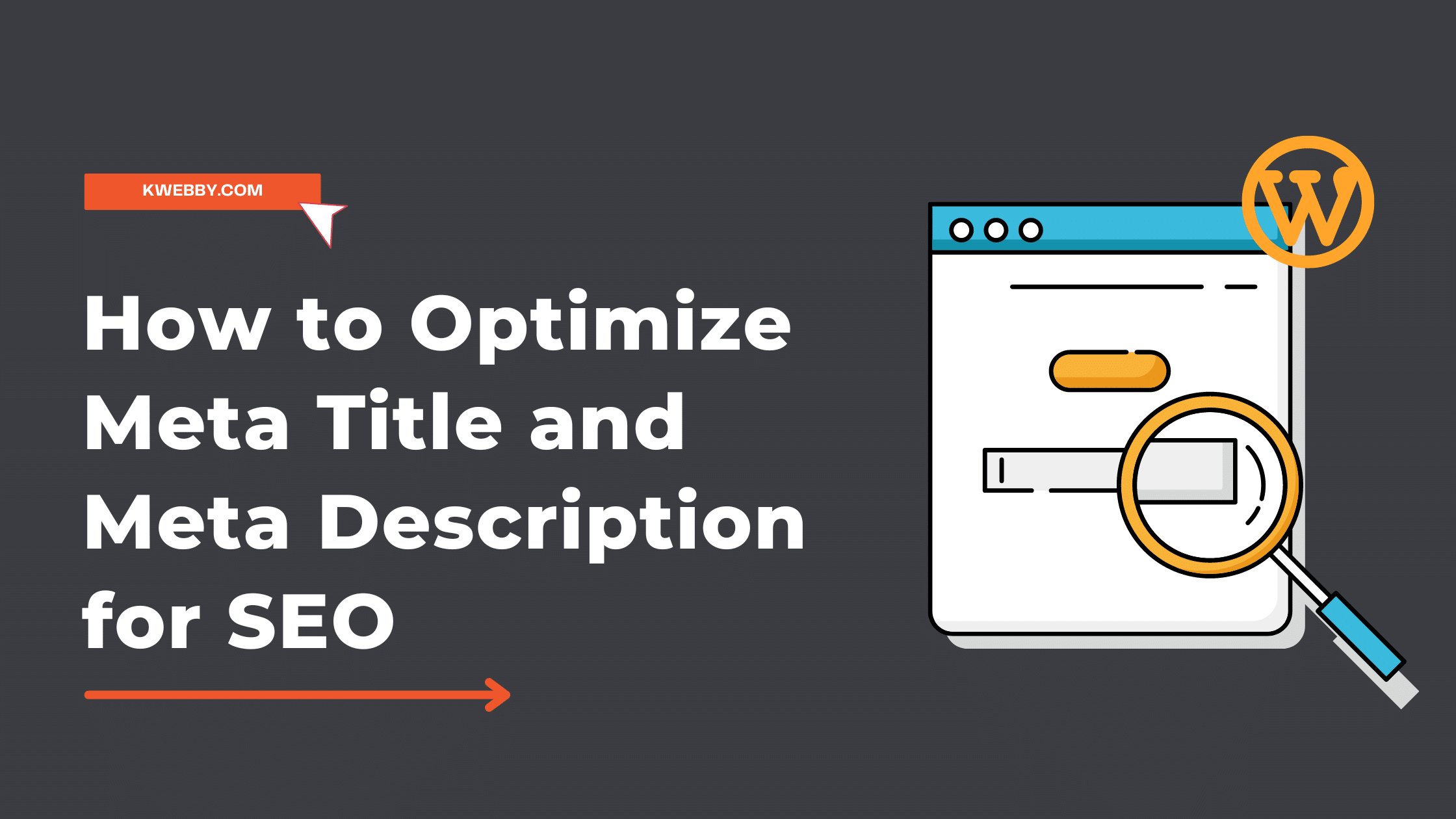
How to Optimize Meta Title and Meta Description for SEO in WordPress in 2024
Choose Your Language:
Meta titles and meta descriptions play a pivotal role in Search Engine Optimization (SEO). They function as the first point of contact between a potential website visitor and your content on search engine result pages.
The meta title succinctly summarizes the content of a page, assisting search engines in understanding the relevance of the page to a user’s search query. Similarly, the meta description provides a brief overview of the page, enticing users to click through to your site from the search results.
WordPress, a popular content management system, significantly aids in SEO optimization. Its abundant plugins like RANKMATH and All in One SEO Pack simplify the process of adding meta titles and descriptions, ensuring optimal keyword usage, and improving overall site visibility.
WordPress’s inherently SEO-friendly code structure further enhances a site’s search engine rankings.
Also Read;
- What Are Meta Tags? Is it Important for SEO? Let’s Find Out !
- Ultimate Guide to Generate Social Media Meta Tags for Your Website
- 9 Most Important Meta Tags You Need to Know for SEO
1 What is a Meta Description?

A Meta Description is a brief summary, typically between 150 to 160 characters, that describes the content of a web page. It is displayed on search engine results pages (SERPs) beneath the clickable web page title.
While it does not directly influence a page’s ranking on SERPs, it plays a critical role in attracting user attention and persuading them to click on the link.
You can read an extensive guide from Google itself on how to write meta descriptions here.
The influence of meta descriptions on click-through rates (CTRs) is significant. A compelling and relevant meta description can act as a powerful call-to-action, enticing users to click on your webpage instead of others in the SERP.
It is essentially a digital “elevator pitch” for your content, and when optimized correctly with relevant keywords and a clear, concise description of the page’s content, it can significantly enhance your CTR.
Remember, a higher CTR often leads to increased website traffic and, potentially, higher conversion rates.
2 Meta Title vs. Site Name: The Differences and Importance in SEO

The meta title and site name serve different yet interconnected roles in SEO.
While the site name is the identity of your website and often appears in the header of your site, the meta title is an HTML tag presented in the head section of each web page. It is the title that appears on SERPs, bookmarks, and browser tabs.
Unlike the site name, which is typically consistent across your site, the meta title varies from page to page, reflecting the unique content of each page.
The distinction between the two becomes crucial when considering on-site SEO. While it’s essential to have a catchy and recognizable site name, it’s arguably even more vital to have compelling and accurate meta titles.
Meta titles play a significant role in on-site SEO as they directly influence your search engine rankings. Search engines use these titles to understand the content of the pages, making it essential to include relevant keywords in your meta title.
An optimized meta title can increase the visibility of your webpage in SERPs and improve the CTR, leading to higher website traffic. Hence, while site names help establish brand consistency and recognition, it is the meta titles that significantly boost your SEO efforts.
Also read, How to Make My WordPress Site Visible on Google Search in 7 Proven Ways
3 What is a Focus Keyphrase in SEO?
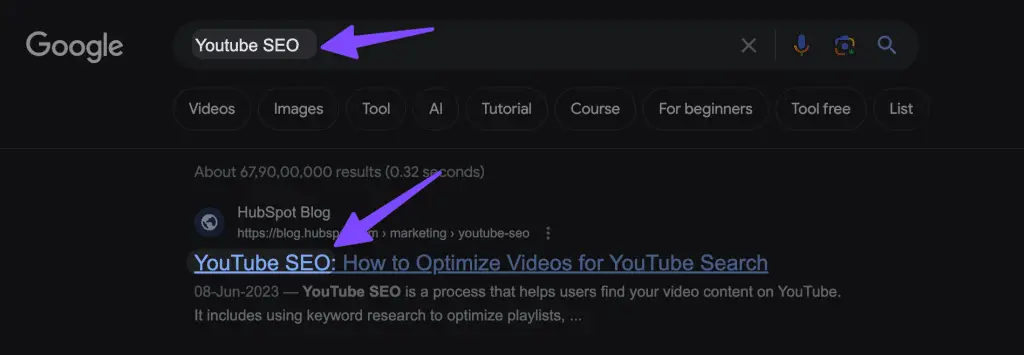
In SEO terminology, a Focus Keyphrase is the primary keyword or phrase that you want your webpage to rank for in search engine results. It is the term that you believe people are most likely to use when searching for the information that you are presenting on your webpage.
When optimizing your content, the focus keyphrase should be relevant to your topic and ideally, appear in several important places including your title tag, meta description, URL, and throughout your content.
4 Role of Focus Keyphrase in Content Optimization
The role of a focus keyphrase in content optimization is substantial. It helps search engines understand the primary theme of your content, hence improving your chances of ranking higher for that key phrase.
By strategically placing the focus keyphrase in the title, headers, body of the content, and meta tags, you help search engines index your content correctly, leading to improved visibility on SERPs.
5 Importance of Unique Focus Keyphrases for Different Posts
Using unique focus keyphrases for different posts is crucial in SEO strategy. When you use a unique key phrase for each post, you avoid competing with your own content for search rankings. This practice allows you to cover a wider range of search queries, increasing the chances of your website appearing in more varied searches.
Moreover, unique keyphrases ensure that each post is tailored to a specific topic, making it more relevant and likely to rank higher for specific queries. This not only improves your SEO but also enhances the user experience by providing visitors with highly relevant content for their search.
6 Optimize Meta Title and Meta Description Using RANKMATH for Optimization
RANKMATH is a robust and user-friendly SEO plugin for WordPress, offering a comprehensive suite of features to improve your website’s ranking and visibility on search engines. This powerful plugin allows you to set meta titles and descriptions, focus keyphrases, generate XML sitemaps, and perform a host of other SEO enhancements with ease.
7 Steps to Add Focus Keyphrase, Meta Title, and Meta Description using RANKMATH
Installing and Activating RANKMATH: From your WordPress dashboard, navigate to Plugins > Add New. Signup and download RANKMATH Plugin here and upload and install and activate the plugin.

Adding Focus Keyphrase: After creating or editing a post, scroll down to the RANKMATH SEO Meta Box underneath the text editor if you’re using an old editor or you can see the RANKMATH icon on the right if you’re using Gutenberg Editor;
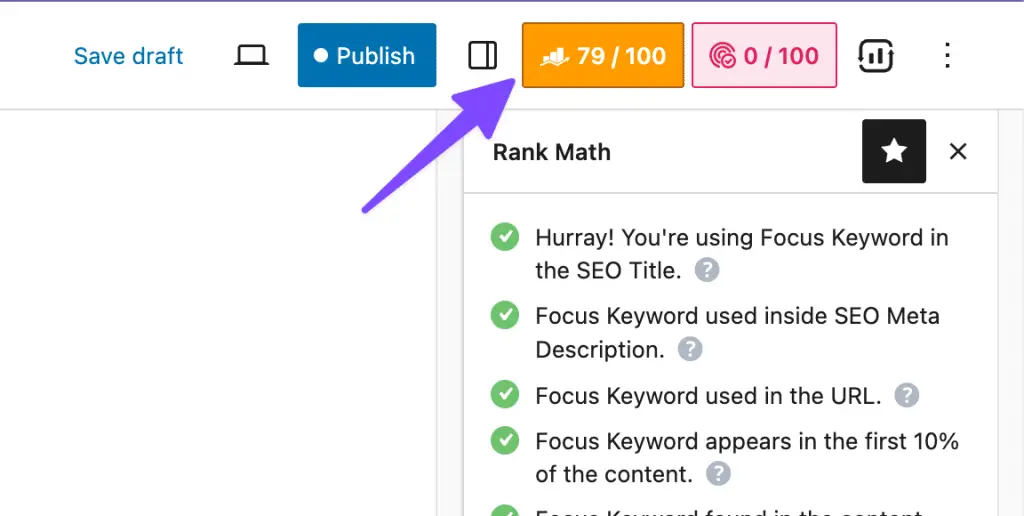
Now, when you click on the icon a new interface will open on your sidebar with all RANKMATH On-page content optimization checklist, you need to scroll down and click on “Edit Snippet”;
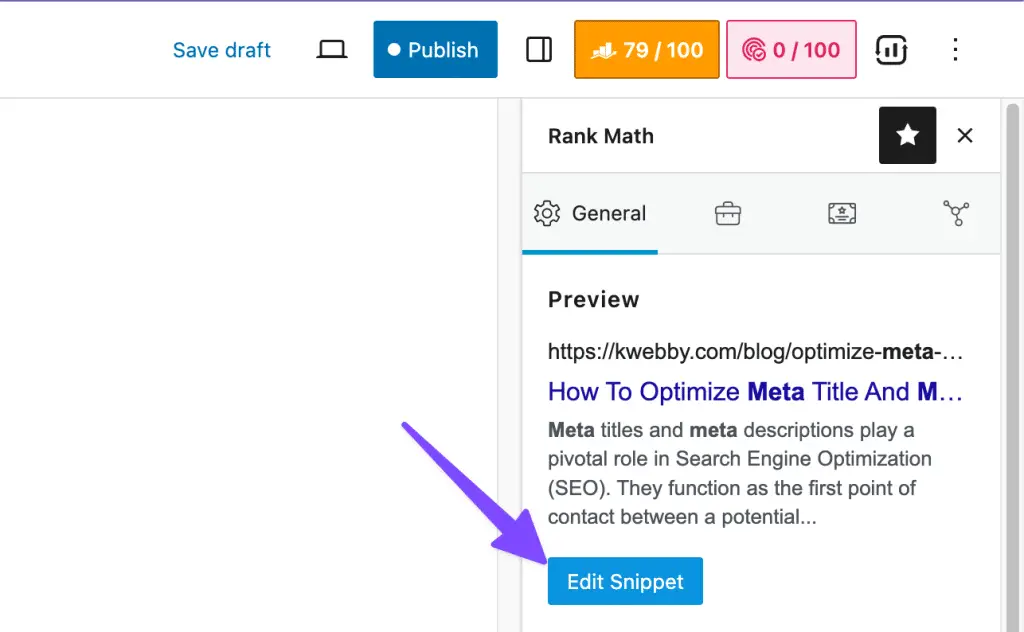
Now you will see a new popup which enables you to edit the Meta Title and Meta description as below;
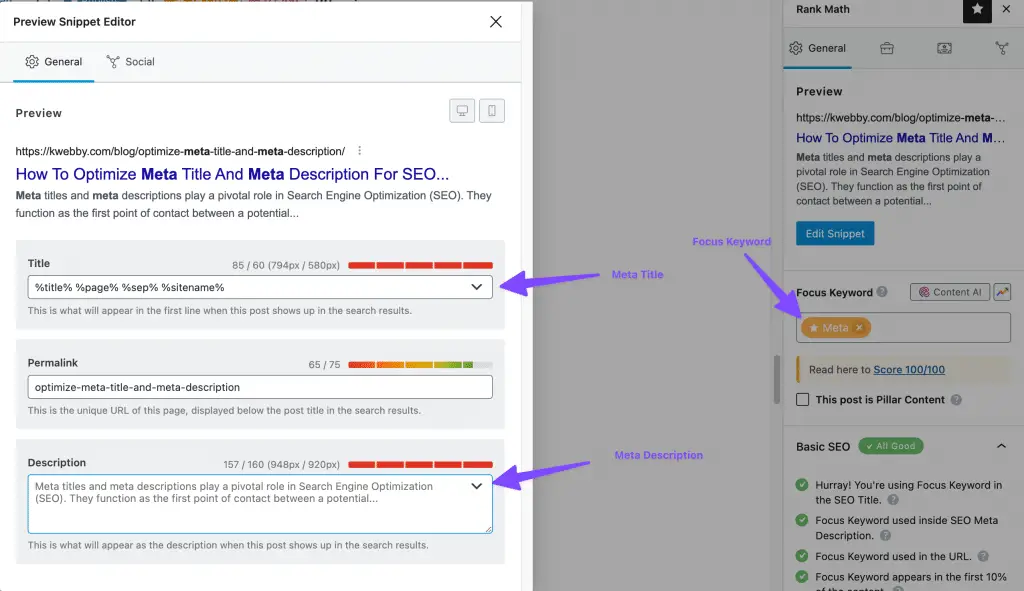
Now, You should Add your Focus keywords into your Meta description as well as your Meta Title. You need to add Meta Title manually, whatever you write in H1 section of your content will be added to Meta title along with the site name;

Once you’ve filled out these fields, save or publish your post. Now, your chosen focus keyphrase, meta title, and meta description are set and ready to enhance your post’s SEO performance.
8 Optimizing the Homepage
The homepage is often the first point of contact between your website and potential visitors. It holds significant importance in SEO as it’s frequently the most visited and linked-to page on a website.
A well-optimized homepage can drastically improve your site’s visibility in search engine results and increase the click-through rate significantly.
9 Customizing the SEO Title and Meta Description for the Homepage
Customizing the SEO title and meta description for your homepage is crucial for effective SEO. The SEO title serves as the headline for your site on search engine results pages (SERPs) and should encapsulate the central theme of your website while incorporating your primary keyword or brand name.
The meta description, on the other hand, offers a brief summary of your site and should be designed to entice users to click on your site. Include your primary keyword, a compelling call-to-action, and ensure it aligns with the content of your homepage.
With RANKMATH, customizing these elements is simple. Navigate to Rank Math > Titles & Meta > Homepage from your WordPress dashboard.
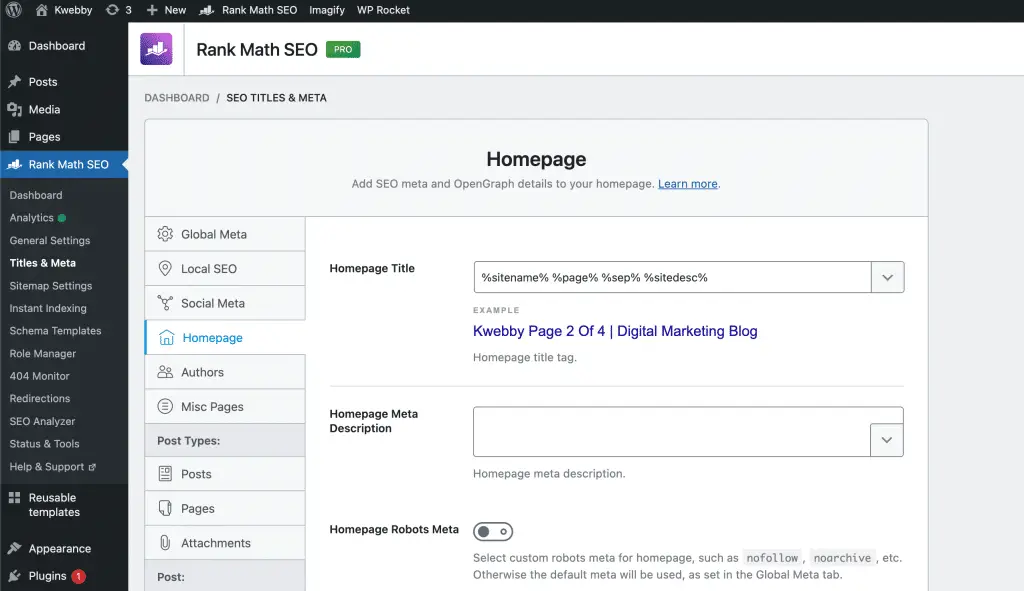
Here, you can input your custom SEO title and meta description. Always remember to click ‘Save Changes’ when you’ve finished.
By strategically optimizing these elements, you can improve your homepage’s visibility in search results, enhance your website’s overall SEO, and attract more visitors.
10 Static vs. Dynamic Homepages
Optimizing a static vs. dynamic homepage requires a slightly different approach due to its unique qualities. A static homepage, often called a ‘landing page,’ is typically content-rich and doesn’t change frequently. They are useful for sites that offer a core product or service. For a static homepage, the meta details should be carefully crafted to highlight the main offerings and include the most vital keywords.
On the other hand, a dynamic homepage changes regularly, usually pulling in the most recent content from the site such as blog articles or product updates. This frequent change necessitates a more general but still keyword-rich meta description and title that encapsulates the overall theme of the site rather than specific products or posts.
To edit meta details with RANKMATH based on the type of homepage, follow similar steps as above:
- Navigate to Rank Math > Titles & Meta > Homepage on your WordPress dashboard.
- If your site has a static homepage, write a specific, keyword-rich SEO title and meta description that accurately represents the content of the page.
- If your site has a dynamic homepage, write a general yet compelling SEO title and meta description that broadly encapsulates the content visitors might find on your site. Include general keywords relevant to the overall theme of your site.
- Click ‘Save Changes’ when you’ve finished.
This way, you can appropriately optimize the meta details based on your homepage’s nature, thereby increasing its SEO effectiveness.
11 More WordPress SEO Resources
- How To Add Internal Links In WordPress Automatically in 1 Click
- How to Noindex Low-Value Content in WordPress in 2 Simple Steps
- How to Optimize Images for SEO In WordPress in 2023 (Only Guide You Need!)
- How To Mark Up Your Posts/Pages With Schema In WordPress To Skyrocket SEO (2 Easy Way)
- How To Enable Seo-Friendly Permalinks In WordPress in 2023
- How To Show ‘Last Updated’ Dates In WordPress (3 Easy Methods)
12 Frequently Asked Questions
13 Do I need a plugin to add a WordPress meta description?
While it’s indeed possible to add meta descriptions to your WordPress posts manually, using SEO plugins like RANKMATH SEO can greatly simplify the process. These tools provide an intuitive interface where you can easily input your meta description for each post and see a real-time preview of how it will appear in search engine results.
This not only makes the process more efficient but also allows you to optimize your descriptions effectively for better SEO performance.
14 Does changing the meta description affect SEO?
Yes, changing the meta description can indeed affect SEO. The meta description provides a concise summary of a web page’s content to search engines and users. It appears directly under the SEO title in search engine results pages (SERPs) and offers potential visitors a snapshot of what they can expect to find upon clicking.
A well-crafted meta description can garner attention, intrigue users, and improve click-through rates, all of which can lead to better site visibility and higher rankings in SERPs.
Therefore, it’s crucial to ensure your meta descriptions are always optimized and accurately represent the corresponding page’s content.
15 How do search engines treat emojis in titles?
Search engines do indeed recognize and support emojis in titles, but their usage should be approached with caution.
It’s important to note that while emojis can make your site appear more engaging and relatable, especially to younger audiences, their impact on organic traffic is somewhat uncertain and varies across different search engines and regions.
Moreover, excessive use of emojis can potentially make your site seem less professional.
Therefore, it’s recommended to use emojis judiciously and only when they clearly contribute to the title’s relevance and appeal. It is also essential to continuously monitor any changes in engagement or search rankings after incorporating emojis into your SEO strategy.
16 Conclusion
Optimizing the meta title and description for your WordPress posts and homepage is a key component of effective SEO. With RANKMATH, you can easily customize these elements to boost your search engine visibility and attract more visitors.
By following the steps outlined in this guide, you can make sure that each post is tailored to a specific topic while also ensuring your homepage accurately represents the content of your site. This way, you can make sure that your website is optimized for SEO and provide a great user experience for all visitors.
Ultimately, optimizing meta titles and descriptions may be one of the most important factors in driving organic search traffic to your WordPress website. It’s easy to overlook this crucial step; however, by making sure that each post and homepage are accurately represented on search engine results, you can expect to see an increase in organic traffic.
To fully optimize your WordPress site for SEO, take a look at our other SEO guides which cover topics such as creating XML sitemaps, optimizing page speed, and adding schema markup. With the right combination of these techniques, you can make sure that your website reaches its fullest potential.
Of course, SEO is an ever-evolving field, and search engine algorithms change all the time. Be sure to stay up to date on the latest trends and adjust your strategy accordingly for the best results. With a bit of effort, you can achieve high rankings in search engine results pages and optimize your WordPress website for success.
Good luck, and happy optimizing!



